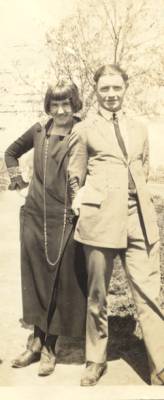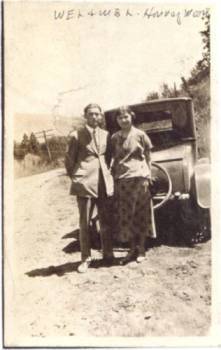Loughary Lines
Loughary Stories
Bagan Stories
ThinkPint2.com home
|
|
Second Coming; the great depresson in the Oregon Territory
My parents returned to Oregon in 1935 after having lived 7 years in the Okanogan Country, which is also a county by the same name in Washington up along the Canadian border. They had moved from Stanfield, Oregon, to a wide spot in the road named Orient, Washington, shortly after they were married June 7, 1927. He was Oregon born, she coming from Minnesota at age 10. Mother had a teaching certificate and Dad was a high school graduate with a variety of work experience, but no occupational training per se. I suppose they were adventurous up to a point, who knows about one's parents before they were parents and even after as a matter of fact, but the truth is probably that they went where "the work was." It was mill work (mill assumes lumber in the Oregon Territory). Just why they selected Orient is a mystery to me because there must have been work closer to Stanfield. One reason could easily have been friends who had relocated there and another was better pay. Or, perhaps they just wanted to move on! That makes sense, especially if you were from Stanfield. We never got around to discussing this. All my sister Marilyn and I knew was that Orient was a place between their getting married in Stanfield and starting a family in Omak
 Maragret & Red
Maragret & Red |
In the 1920s (and currently for that matter) there were few population centers in the Oregon Territory. Orient was (is) not one of them. A web map shows fewer than 10 streets. Orient is on US 395 which runs north and south and the Kettle River which parallel the mighty Columbia on its way south and then west and eventually into the Pacific. Highway 395 or what ever road preceded it had its share of traffic in those days. It was an artifact of the Noble Experiment known as Prohibition. The US eventually and gradually went totally dry (legally) with national legislation in 1920 and remained so until repealing legislation in 1933. In the meantime, Americans drank more, not less.
"PROHIBITION (1920–1933 R.I.P.) was known as The Noble Experiment. The results of the experiment are clear: innocent people suffered; organized crime grew into an empire; the police, courts, and politicians became increasingly corrupt; disrespect for the law grew; and the per capita consumption of the prohibited substance alcohol—increased dramatically, year by year, for the thirteen years of this Noble Experiment, never to return to the pre-1920 levels."(1)
Canada was not dry as the automobile traffic south of the border testified. A story Dad told enough for me to remember was about the quick trips up to Canada for booze. The police, probably the Washington State Patrol or it could have been the Feds, apparently were assertive in monitoring illegal booze even this far out in the boonies of Washington. A favorite story involved cops stripping car door upholstery in search of hidden containers in the door panels. My father was not a drinking man, nor was he prone to illegal activities, so I assume the "Canadian runs" were essentially recreational activities.
The Orient period was brief and they moved west to the small Washington town of Omak. Omak and Okanogan are only a few miles apart, the later being the coutry seat and the former the larger of the two burgs. The area is a couple foot steps closer to civilization than Orient and that must have accounted in part for their moving. Some of their best poverty stories are set in Omak after the beginning of the Great Depression in 1929. I was born November, 1930, so I assume their relocation was about 1928 or 1929. Life in the rural parts of the Oregon Territory were still relatively primitive and many people living in towns grew their own gardens and canned fruits and vegetables for the coming winter. Canned, of course, refers to preserving food in jars and was often a family project in summer and early fall. This family "tradition" lasted through the war years and well and into the 1950s long after leaving Omak. Home canning was replaced by preserving in tins at a local self-service cannery after the war and most of the fruits and vegetables were purchased at road side stands from local farmers. It was a habit hard to break for many people who lived through the Depression.
The poverty story that epitomized the Omak Depression years hung on the amount of money remaining after completing each week's shopping. "We were lucky to have a nickel for a candy bar when we finished," as I recall Mom's often repeated punch line. That was probably literally true. Dad was working in the Biles and Coleman mill, pulling on the green chain I assume, and Mom packed apples in the fall and early winter. During moments of reminiscing, she noted how much she enjoyed working in the apple warehouses. Okanogan county is one of world's prime apple orchard areas, or at least it was. The orchards were set on raised mini plateaus and irrigated via ditches. After the fruit was picked it was stored in wooden boxes (all my life I've gauged the size of a box by how it compared to a standard wooden apple box) in large warehouses until Spring. (The nature of the climate in the Okanogan valley provided its own cold storage during those seasons.)The prime fruits were hand selected and packed in tissue paper.
The packers, all women, sat on stools at wrapping stations with full bins of prime grade apples on one side, empty apple boxes on the other and a foot square board in front of them. The board served as a table and fixed to it was a thin pointed looped spike upon which a stack of tissues had been impaled. The packing procedure consisted of taking an apple from the bin in one hand, yanking off a tissue in the other and tightly wrapping the latter around the former and then carefully "packing" the wrapped fruit in the box. Hour after hour the women would pack unending bins of apples. I have always speculated that it beat house work for Mom, the evidence of which is that she was employed as a teacher most of her adult life. Even though her desire was to escape cleaning house, the irony is that she was compulsive about having a clean house, and so found her self with two jobs instead of one.
 Orient Bound
Orient Bound |
My parents spoke with great satisfaction regarding life in Omak during the first half of the 1930s. They were both articulate and receptive to offers of friendship and as I have gathered viewed as an attractive couple. Social life was largely a do-it-yourself proposition and for different reasons both fit easily in small gatherings. They spoke of middle aged family couples and younger marrieds. The former were probably better off financially, but poverty in some form was the norm so everyone was in the same economic boat, even though some rode higher than others. Playing cards, working on jig saw puzzles, and other games provided the foundation for satisfying evening gatherings. Community activities were important, some probably sponsored by schools and churches. A mystery in this regard to me, was my hitting the boards at an early age in a production of "Tom Thumb's" wedding.
Tom Thumb? The reference is to a Barnum and Baily Circus Act starring a group of midgets that was famous for a time. Most newspapers carried illustrated stories of Tom Thumb, his wife and their friends. What was the appeal in those days? Cute; odd perhaps. Evidently many small town parents (women mostly, I suppose) thought it a neat idea to dress up kids as adults (thus the midget notion) and stage weddings in parks and gardens in the late summer and spring. The shows were light on dialogue by necessity, costumes home sewn and the action as you can imagine was easy to follow, especially if yours or a neighbor kid had been participating in one of the many rehearsals prior to the final (and only) production. A goodly number of kids in town did. There were no surprises, except the inevitable mistakes of the young actors, which were, of course, the highlights of the show. My role, as I was told many times, was an Usher. Ushers at Tom Thumb weddings got lots of on-stage time, so it was a much sought after role (by mothers.)
Semi-professional baseball was important and even small communities fielded teams. I have no idea how much players were paid in addition to free uniforms, but enough to keep a kid out of college ball and the rare scholarships if it got around he had played semi-pro. Dad had been a star Stanfield High School athlete and was selected to pitch for the Omak team. I have pictures of him in his uniform. (Wandering through a sans athletics youth and adolescence, it occurred increasingly to me that my sportless life must have disappointed him. Playing in the band just didn't cut it. He never let on that he was disappointed, but then I can't recall any invitations to shoot baskets or pass the ball around in the front yard, either.)
Mom was hired to do some substitute teaching in Omak. Perhaps this was a convenient way to re-inter the full time teaching career that she began at age 19 on an Indian Reservation school a few years before. It would be nearly 30 years later before she retired. Near as I can determine, life in Omak was okay and probably would have taken a major turn of events to motivate their relocating.
The turn that precipitated the family relocating from Omak to Eugene, Oregon turned out to be labor disputes and strikes at Biles and Coleman mill in Omak . During the middle of one strike, We moved to Eugene where my mother's brother and his wife lived and could put us up while Dad searched for work. In a week or two a telegram from the B&C mill manger stated that the strike was settled and offered of a better position for Dad. He drove back to Omak and found that the strike was on again and returned to Eugene for ever thus completing their second coming to Oregon, in a manner of speaking.
Following an up-from-the mat return, my parents lived reasonably happy, full and satisfying lives in Eugene. From my perspective later as a social scientist, their lives were eventful, interesting and instructive in a broader context as well, as I hope to discuss in further pieces. Dad died in 1973 and Mom in 1989. Their return to the Oregon by way of Omak was to a significant degree responsible for their life satisfaction. I sometimes think of their trail as one effective means of making the transition into adult family responsibilities. There can be something healthy and instructive about making a trial run as a young couple, getting to know one an other and developing the basic rules of the marriage relationship before taking up the real match in another place. Omak was probably such a place for them. In any event, it beat a dusty trail and the bed of a covered wagon.
1. McWilliams, Peter, Prelude Press copyright 1996, retrieved under "Depression" from Google
|

